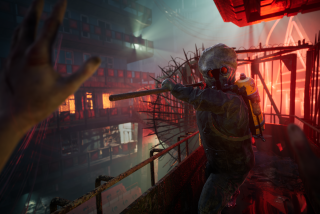Disney Rubs the Video Lamp : Entertainment: The studio finally enters the high-tech interactive market by announcing a partnership to create “Aladdin”--the game.
- Share via
CHICAGO — Walt Disney Co., which has distanced itself from the new technology scramble, entered the fray on Friday with an announcement that it is helping to develop an “Aladdin” video game that will incorporate cinematic-style storytelling and humor.
The project, detailed by studio Chairman Jeffrey Katzenberg at the Consumer Electronics Show here, represents a first step into the expanding world of interactive technology for the studio. Its partners in the endeavor are Virgin Games and video game manufacturing giant Sega.
“A lot of people have wondered if Disney was ever going to leap into this field,” Katzenberg said. “Now the technology has presented us with an opportunity to actually bring things to it. In the past, video games have not generally offered a sense of story or emotion--that’s where we come in.”
Virgin developed the animation technique being used in “Aladdin,” based on the animated hit. The technique, which makes the game’s graphics smoother and more like TV cartoons than traditional video games, is not cheap.
Martin Alper, president of Virgin Games, the Irvine-based subsidiary of Virgin Group, estimates “Aladdin” development costs at $1 million to $1.5 million, about four times that of the average video game. But if sales match Sega’s expectations--1 million $50-$60 cartridges by the end of 1993--production costs should be covered.
Besides a cross-marketing campaign in which every “Aladdin” home video will contain a brochure touting the game, Sega will spend up to $4 million marketing the game, which is for its Genesis machine, when it is released this fall.
The triumvirate did not skimp on the press conference either. The presentation, put on by Walt Disney World, featured smoke, mirrors, genies and a magic lamp.
The three partners said their collaboration went smoothly. Virgin’s Alper even complimented Katzenberg--apparently without tongue-in-cheek--on the frequency with which he sent storyboards back for revisions.
“I know Jeffrey is known to micro-manage projects,” Alper said later, “but I have no complaints. He came up with some of the best sight gags.”
A scene in which Aladdin is fencing with one of his many foes, and the villain’s pants fall down to reveal polka-dotted boxer shorts, for example, was Katzenberg’s idea.
While it is unusual for a studio chief to immerse himself in the minutiae of a product that has no dialogue, no director and no hope of ever seeing the big screen, the practice is becoming more common. Disney is one of several studios that see emerging digital technologies as providing them entree to the $5-billion video game business.
MCA, for example, which like Disney has always licensed its movies to be turned into video games by other software publishers, is developing its own interactive version of “Jurassic Park” to be played on the 3DO Co. machine due out next fall.
Disney is the distributor of “Super Mario Bros.,” a film based on a Nintendo character featured in games that recently surpassed 100 million sales.
The studio plans to continue its venture in video game development with a CD-ROM version of “Aladdin” and perhaps other films from its library. For now, though, “it’s like a movie that hasn’t opened yet,” Katzenberg said. “We’ll have to see what the audience thinks.”






